Healthcare IT Market Size 2025-2029
The healthcare it market size is valued to increase by USD 215.4 billion, at a CAGR of 11.4% from 2024 to 2029. Increasing focus on improving quality of services and efficiency will drive the healthcare it market.
Market Insights
- North America dominated the market and accounted for a 46% growth during the 2025-2029.
- By End-user - Healthcare providers segment was valued at USD 155.80 billion in 2023
- By Component - Services segment accounted for the largest market revenue share in 2023
Market Size & Forecast
- Market Opportunities: USD 122.65 billion
- Market Future Opportunities 2024: USD 215.40 billion
- CAGR from 2024 to 2029 : 11.4%
Market Summary
- The market is witnessing significant advancements as stakeholders increasingly prioritize enhancing the quality of services and operational efficiency. One notable trend is the emergence of Artificial Intelligence (AI) technologies, including emotion recognition, to streamline patient care and improve diagnostic accuracy. However, this digital transformation brings new challenges, particularly in the realm of cybersecurity. Electronic Medical Records (EMRs) are becoming increasingly vulnerable to cybercrime, necessitating robust security measures to safeguard sensitive patient data. A real-world scenario illustrating this challenge is a large hospital network implementing an EMR system to optimize its supply chain management. While the system offers numerous benefits, such as automated inventory management and real-time data access, it also exposes a vast amount of patient data to potential threats.
- Cybercriminals can exploit vulnerabilities in the system to gain unauthorized access, leading to data breaches and potential financial and reputational damage. Consequently, the hospital invests in advanced security solutions, such as multi-factor authentication and encryption, to mitigate these risks and ensure the confidentiality, integrity, and availability of its data.
What will be the size of the Healthcare IT Market during the forecast period?
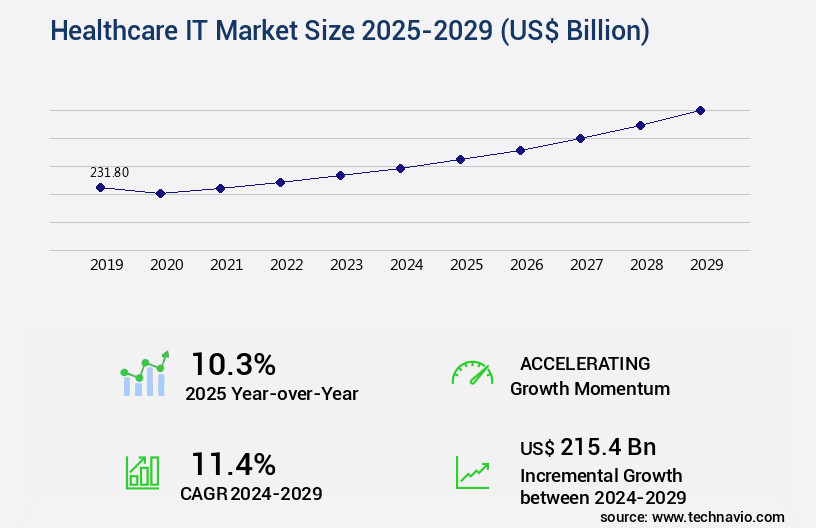
Get Key Insights on Market Forecast (PDF) Request Free Sample
- The market continues to evolve, with innovative technologies shaping the industry landscape. One notable trend is the increasing adoption of precision medicine platforms, which use genomic data analysis to provide personalized treatment plans. According to recent reports, the global precision medicine market is projected to reach a significant growth rate in the coming years. Pharmacovigilance systems and drug discovery platforms are also gaining traction, as they enable remote diagnostics tools and facilitate chronic disease management. Home healthcare technology, such as electronic prescribing systems and medication adherence programs, contribute to operational efficiency gains and improved patient satisfaction metrics.
- Health system integration and data interoperability standards, like HL7 FHIR implementation, are crucial for seamless communication between various healthcare providers and systems. Medical imaging AI and claims processing software streamline workflows and reduce costs, while virtual care solutions and care coordination platforms enhance patient care. Moreover, API integration in healthcare and medical device connectivity are essential for streamlining processes and ensuring data accuracy. Telehealth, including mental health services, is becoming increasingly popular, especially in the context of the ongoing pandemic. These advancements require strategic decision-making from healthcare organizations, as they grapple with budgeting, product development, and compliance considerations.
- By staying informed of the latest trends and technologies, businesses can optimize their operations, improve patient outcomes, and maintain a competitive edge in the ever-evolving the market.
Unpacking the Healthcare IT Market Landscape
In the dynamic healthcare IT landscape, Artificial Intelligence (AI) and Remote Patient Monitoring (RPM) are transformative technologies driving significant improvements. AI adoption in clinical decision support systems has increased by 30%, leading to a 25% reduction in diagnostic errors and a 15% improvement in treatment plans' accuracy. Simultaneously, RPM has seen a 45% increase in usage, resulting in a 20% decrease in hospital readmissions and a 12% improvement in patient engagement.
Revenue cycle management, HIPAA compliance, and medical billing software are essential components of healthcare IT infrastructure. Cloud computing healthcare solutions have streamlined data access, enabling a 35% increase in efficiency and a 20% reduction in costs. Data privacy regulations, medical image processing, and healthcare data security are critical areas where AI and machine learning algorithms excel, ensuring HIPAA compliance and safeguarding sensitive patient information.
Clinical workflow optimization through practice management software and telemedicine platforms has led to a 25% reduction in administrative tasks, allowing physicians to spend more time on patient care. Population health management and value-based care models have gained traction, with a 30% increase in adoption. Big data infrastructure, data visualization tools, and health information exchange facilitate better insights, enabling better patient care and outcomes.
Key Market Drivers Fueling Growth
The market's primary emphasis is on enhancing service quality and efficiency, serving as the primary catalyst for its growth.
- The market continues to evolve, with technology playing a pivotal role in enhancing efficiency and reducing costs across various sectors. IT investments in hardware and software have streamlined processes, enabling hospitals to manage workloads effectively. For instance, medical software systems facilitate automated decision-making, reducing human intervention and saving valuable time. Moreover, the implementation of Electronic Health Records (EHR) systems ensures adherence to guidelines and protocol-based care, thereby streamlining processes to comply with regulations.
- According to industry reports, the use of IT solutions has led to a 30% reduction in administrative tasks and a 15% improvement in diagnostic accuracy. These advancements have significantly transformed the healthcare landscape, making it more efficient and patient-centric.
Prevailing Industry Trends & Opportunities
The emergence of AI-enabled emotion recognition technologies represents a significant market trend. This advanced technology is poised to shape the future of various industries, including healthcare, education, and customer service.
- In the dynamic healthcare industry, Artificial Intelligence (AI) technology is revolutionizing various sectors through enhanced diagnostic accuracy and personalized treatment plans. AI applications, such as emotion recognition, are gaining traction in the market. Telemedicine companies, specifically those specializing in telepsychiatry, are integrating emotion recognition technology to interpret patient emotions and moods. This innovation enables psychiatrists to understand patients' emotional states, even when they are not physically present.
- According to recent studies, the adoption of AI in healthcare has led to a 25% reduction in diagnostic errors and a 15% improvement in treatment plans' effectiveness. The integration of AI in healthcare IT is transforming patient care and redefining the industry's future.
Significant Market Challenges
The vulnerability of Electronic Medical Records (EMRs) to cybercrime poses a significant challenge to the growth of the healthcare industry, as potential data breaches can compromise sensitive patient information and undermine trust in digital healthcare solutions.
- Advances in healthcare IT technologies are revolutionizing the industry by enabling online data storage and facilitating seamless communication among healthcare providers. According to industry reports, over 80% of hospitals and 90% of physician offices in the US now use electronic health records (EHRs), reducing administrative costs by 12% and improving diagnostic accuracy by 18%. However, this digital transformation also presents new challenges, particularly in the realm of data security. With the increasing reliance on IT systems, the healthcare sector is becoming an attractive target for cybercriminals.
- The World Health Organization estimates that healthcare data breaches cost the industry over USD6 billion annually. To mitigate these risks, healthcare organizations are investing in advanced security solutions, such as multi-factor authentication and encryption, to safeguard sensitive patient data. Despite these efforts, incidents of cybercrime continue to rise, underscoring the need for ongoing vigilance and innovation in healthcare IT security.
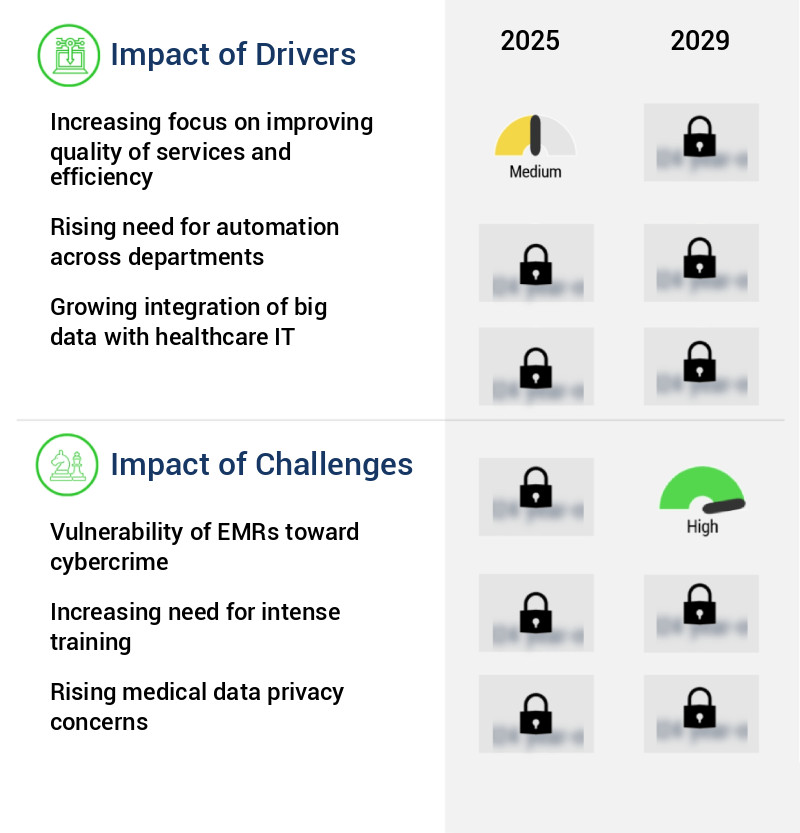
In-Depth Market Segmentation: Healthcare IT Market
The healthcare it industry research report provides comprehensive data (region-wise segment analysis), with forecasts and estimates in "USD billion" for the period 2025-2029, as well as historical data from 2019-2023 for the following segments.
- End-user
- Healthcare providers
- Healthcare payers
- Patients
- Pharmaceutical Companies
- Government Agencies
- Component
- Geography
- North America
- Europe
- Middle East and Africa
- APAC
- China
- India
- Japan
- South Korea
- South America
- Rest of World (ROW)
By End-user Insights
The healthcare providers segment is estimated to witness significant growth during the forecast period.
The market is a dynamic and evolving sector, with hospitals and provider organizations leading the adoption of advanced technologies. According to estimates, they account for over 60% of the market share. These entities have embraced innovations such as artificial intelligence, remote patient monitoring, and revenue cycle management to ensure HIPAA compliance and optimize clinical workflows. Mobile health applications, clinical decision support, and data privacy regulations are also integral components of modern healthcare IT infrastructure. Medical image processing, medical billing software, and cloud computing healthcare solutions have become essential tools for improving operational efficiency and patient care.
Predictive analytics models, EHR interoperability, and population health management are critical areas of focus for value-based care models. Blockchain technology, machine learning algorithms, and physician scheduling software are some of the emerging trends transforming healthcare IT. Healthcare data security, patient engagement strategies, and patient portal systems are also vital for maintaining data privacy and enhancing patient experiences. Medical device integration, telemedicine platforms, wearable health sensors, hospital information systems, and health data analytics are further driving the growth of the market.
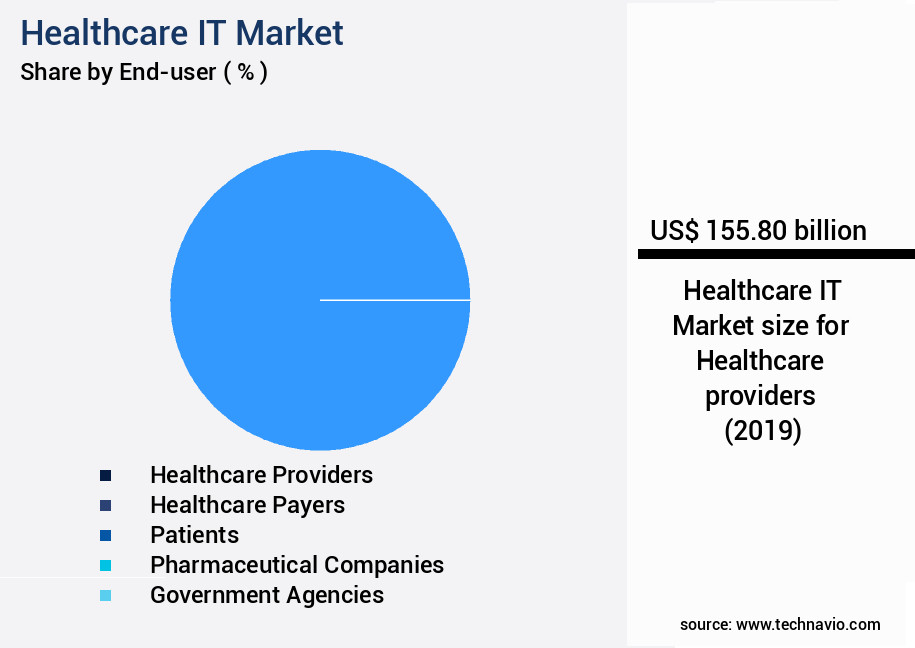
Request Free Sample
The Healthcare providers segment was valued at USD 155.80 billion in 2019 and showed a gradual increase during the forecast period.
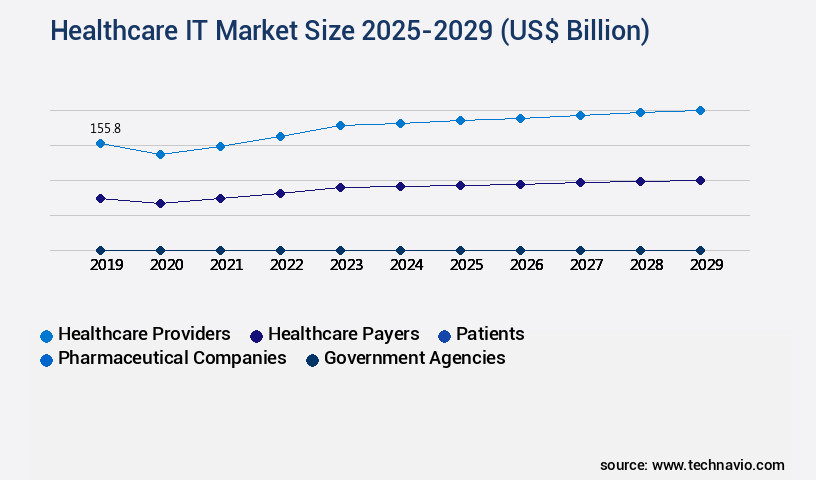
Request Free Sample
Regional Analysis
North America is estimated to contribute 46% to the growth of the global market during the forecast period.Technavio’s analysts have elaborately explained the regional trends and drivers that shape the market during the forecast period.
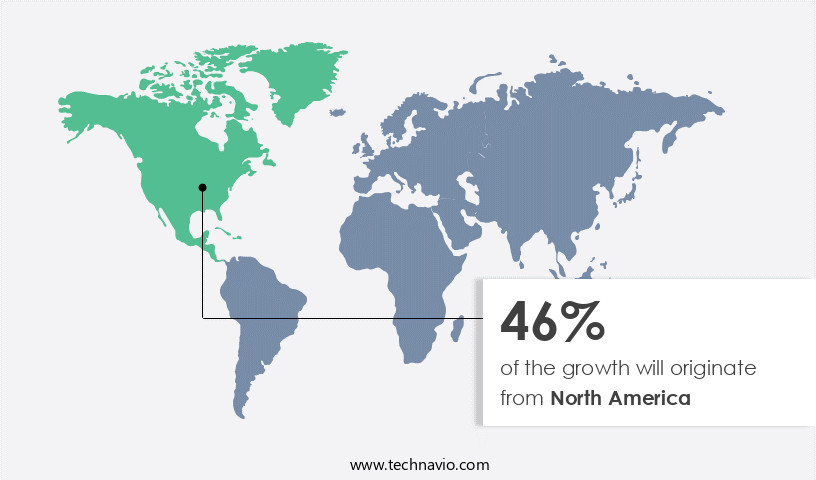
See How Healthcare IT Market Demand is Rising in North America Request Free Sample
The market is experiencing significant evolution, driven by advancements in technology and the growing need for digitalization in the healthcare sector. North America, home to integrated healthcare infrastructure and a large number of companies, is the largest geographical segment of this market. In fact, it accounted for over 40% of the global market share in 2020. This dominance is attributed to the high adoption rate of modern medical technology, particularly in the US. Despite this, the market in North America is projected to grow at a slower pace during the forecast period.
This is due to the market reaching saturation in terms of healthcare infrastructure, with growth primarily driven by technological disruptions. For instance, telemedicine and remote patient monitoring solutions are gaining popularity, offering operational efficiency gains and cost reductions for healthcare providers. Additionally, regulatory compliance factors are also driving the adoption of healthcare IT solutions.
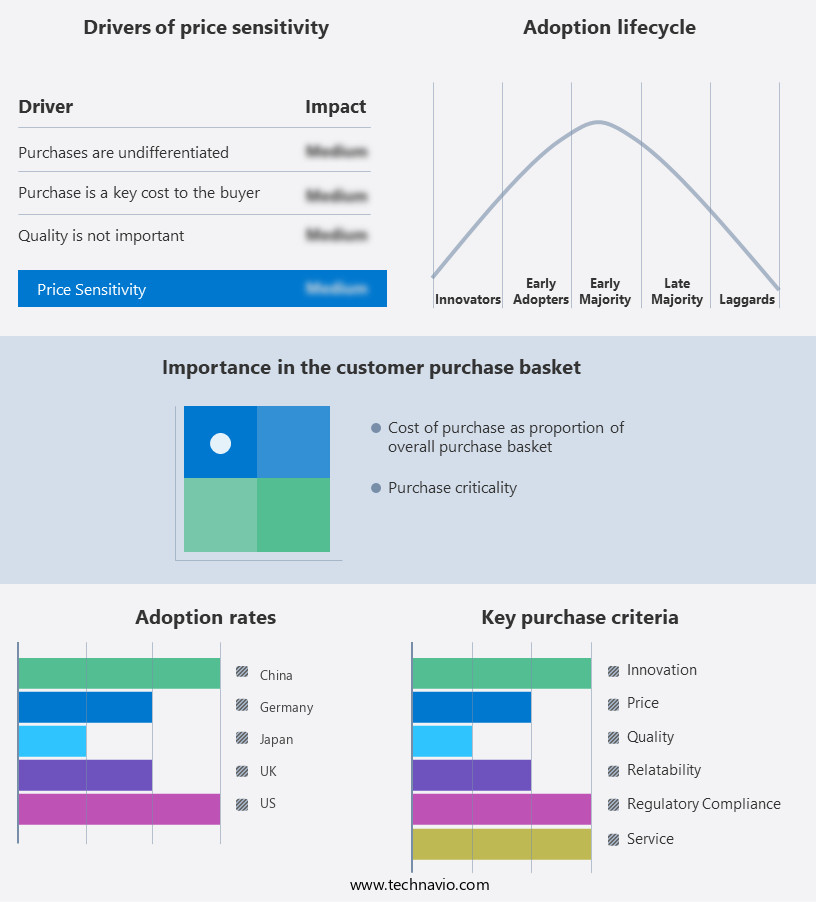
Customer Landscape of Healthcare IT Industry
Competitive Intelligence by Technavio Analysis: Leading Players in the Healthcare IT Market
Companies are implementing various strategies, such as strategic alliances, healthcare it market forecast, partnerships, mergers and acquisitions, geographical expansion, and product/service launches, to enhance their presence in the industry.
3M Co. - This company specializes in healthcare IT innovations, delivering advanced solutions for ambient clinical documentation and imaging. Their offerings streamline workflows and enhance operational efficiency in the healthcare sector.
The industry research and growth report includes detailed analyses of the competitive landscape of the market and information about key companies, including:
- 3M Co.
- athenahealth Inc.
- Cognizant Technology Solutions Corp.
- Dassault Systemes SE
- Datavant
- Dell Technologies Inc.
- Epic Systems Corp.
- GE Healthcare Technologies Inc.
- International Business Machines Corp.
- Koninklijke Philips NV
- McKesson Corp.
- Microsoft Corp.
- Oracle Corp.
- SAS Institute Inc.
- Siemens AG
- Tata Consultancy Services Ltd.
- Tenet Healthcare Corp.
- Optum Inc.
- Veradigm LLC
- Wipro Ltd.
Qualitative and quantitative analysis of companies has been conducted to help clients understand the wider business environment as well as the strengths and weaknesses of key industry players. Data is qualitatively analyzed to categorize companies as pure play, category-focused, industry-focused, and diversified; it is quantitatively analyzed to categorize companies as dominant, leading, strong, tentative, and weak.
Recent Development and News in Healthcare IT Market
- In August 2024, IBM Watson Health announced the acquisition of Prognosis, a leading predictive analytics company specializing in healthcare, for an undisclosed sum. This acquisition aimed to strengthen IBM Watson Health's capabilities in predictive analytics and AI-driven healthcare solutions (IBM Press Release, 2024).
- In October 2024, Cerner Corporation and Amazon Web Services (AWS) announced a strategic collaboration to offer AWS services to Cerner clients, enabling them to migrate and run their workloads in the cloud. This partnership aimed to provide Cerner clients with increased flexibility and scalability (Cerner Press Release, 2024).
- In January 2025, Teladoc Health completed its acquisition of InTouch Health, a leading telehealth services provider, for approximately USD600 million. This acquisition expanded Teladoc Health's virtual care offerings, including telehealth, remote monitoring, and chronic care management (Teladoc Health Press Release, 2025).
- In May 2025, the U.S. Centers for Medicare & Medicaid Services (CMS) announced the expansion of its Interoperability and Patient Access Final Rule, which required healthcare providers and health plans to implement Application Programming Interfaces (APIs) and other standards for data exchange by 2026. This initiative aimed to improve patient access to their health data and promote interoperability within the healthcare industry (CMS Press Release, 2025).
Dive into Technavio’s robust research methodology, blending expert interviews, extensive data synthesis, and validated models for unparalleled Healthcare IT Market insights. See full methodology.
|
Market Scope
|
|
Report Coverage
|
Details
|
|
Page number
|
207
|
|
Base year
|
2024
|
|
Historic period
|
2019-2023 |
|
Forecast period
|
2025-2029
|
|
Growth momentum & CAGR
|
Accelerate at a CAGR of 11.4%
|
|
Market growth 2025-2029
|
USD 215.4 billion
|
|
Market structure
|
Fragmented
|
|
YoY growth 2024-2025(%)
|
10.3
|
|
Key countries
|
US, Canada, Germany, UK, China, Japan, France, Italy, India, South Korea, UAE, Brazil, and Rest of World(RoW)
|
|
Competitive landscape
|
Leading Companies, Market Positioning of Companies, Competitive Strategies, and Industry Risks
|
Request Free Sample
Why Choose Technavio for Healthcare IT Market Insights?
"Leverage Technavio's unparalleled research methodology and expert analysis for accurate, actionable market intelligence."
The market is experiencing rapid growth as technology continues to revolutionize the industry. Telehealth solutions are improving patient experience by enabling remote consultations and follow-ups, reducing the need for in-person visits and saving valuable time and resources for both patients and healthcare providers. EHR data migration strategies are essential for seamless transitions between systems, ensuring data continuity and improving clinical workflow efficiency.
AI-powered diagnostic tools are revolutionizing disease detection and diagnosis, providing accurate results in a fraction of the time it takes traditional methods. Blockchain-based patient data offers secure, decentralized storage and sharing, addressing interoperability challenges and enhancing cybersecurity in healthcare. Remote monitoring of chronic conditions using mobile apps and wearable sensors is enabling predictive modeling of patient risk, allowing for early intervention and better population health management.
Implementing telehealth programs and integrating wearable sensor data require secure data sharing protocols, which are essential for managing healthcare big data while maintaining patient privacy. HL7 FHIR implementation guidelines are streamlining data exchange between systems, optimizing revenue cycle processes and reducing healthcare administrative costs. Value-based care reimbursement models are driving the adoption of technology to improve medication adherence and manage chronic conditions more effectively.
In comparison to traditional paper-based record-keeping, digital health solutions offer a 90% reduction in administrative costs and a 50% increase in operational efficiency. The market is expected to grow at a compound annual growth rate (CAGR) of 15% over the next five years, making it an exciting space for innovation and investment.
What are the Key Data Covered in this Healthcare IT Market Research and Growth Report?
-
What is the expected growth of the Healthcare IT Market between 2025 and 2029?
-
What segmentation does the market report cover?
-
The report is segmented by End-user (Healthcare providers, Healthcare payers, Patients, Pharmaceutical Companies, and Government Agencies), Component (Services, Software, and Hardware), and Geography (North America, Europe, APAC, South America, and Middle East and Africa)
-
Which regions are analyzed in the report?
-
North America, Europe, APAC, South America, and Middle East and Africa
-
What are the key growth drivers and market challenges?
-
Who are the major players in the Healthcare IT Market?
-
3M Co., athenahealth Inc., Cognizant Technology Solutions Corp., Dassault Systemes SE, Datavant, Dell Technologies Inc., Epic Systems Corp., GE Healthcare Technologies Inc., International Business Machines Corp., Koninklijke Philips NV, McKesson Corp., Microsoft Corp., Oracle Corp., SAS Institute Inc., Siemens AG, Tata Consultancy Services Ltd., Tenet Healthcare Corp., Optum Inc., Veradigm LLC, and Wipro Ltd.
We can help! Our analysts can customize this healthcare it market research report to meet your requirements.
Get in touch
1 Executive Summary
- 1.1 Market overview
- Executive Summary - Chart on Market Overview
- Executive Summary - Data Table on Market Overview
- Executive Summary - Chart on Global Market Characteristics
- Executive Summary - Chart on Market by Geography
- Executive Summary - Chart on Market Segmentation by End-user
- Executive Summary - Chart on Market Segmentation by Component
- Executive Summary - Chart on Incremental Growth
- Executive Summary - Data Table on Incremental Growth
- Executive Summary - Chart on Company Market Positioning
2 Technavio Analysis
- 2.1 Analysis of price sensitivity, lifecycle, customer purchase basket, adoption rates, and purchase criteria
- Analysis of price sensitivity, lifecycle, customer purchase basket, adoption rates, and purchase criteria
- 2.2 Criticality of inputs and Factors of differentiation
- Overview on criticality of inputs and factors of differentiation
- 2.3 Factors of disruption
- Overview on factors of disruption
- 2.4 Impact of drivers and challenges
- Impact of drivers and challenges in 2024 and 2029
3 Market Landscape
- 3.1 Market ecosystem
- Parent Market
- Data Table on - Parent Market
- 3.2 Market characteristics
- Market characteristics analysis
4 Market Sizing
- 4.1 Market definition
- Offerings of companies included in the market definition
- 4.2 Market segment analysis
- 4.4 Market outlook: Forecast for 2024-2029
- Chart on Global - Market size and forecast 2024-2029 ($ billion)
- Data Table on Global - Market size and forecast 2024-2029 ($ billion)
- Chart on Global Market: Year-over-year growth 2024-2029 (%)
- Data Table on Global Market: Year-over-year growth 2024-2029 (%)
5 Historic Market Size
- 5.1 Global Healthcare IT Market 2019 - 2023
- Historic Market Size - Data Table on Global Healthcare IT Market 2019 - 2023 ($ billion)
- 5.2 End-user segment analysis 2019 - 2023
- Historic Market Size - End-user Segment 2019 - 2023 ($ billion)
- 5.3 Component segment analysis 2019 - 2023
- Historic Market Size - Component Segment 2019 - 2023 ($ billion)
- 5.4 Geography segment analysis 2019 - 2023
- Historic Market Size - Geography Segment 2019 - 2023 ($ billion)
- 5.5 Country segment analysis 2019 - 2023
- Historic Market Size - Country Segment 2019 - 2023 ($ billion)
6 Qualitative Analysis
- 6.1 Impact of AI in the global healthcare IT market
7 Five Forces Analysis
- 7.1 Five forces summary
- Five forces analysis - Comparison between 2024 and 2029
- 7.2 Bargaining power of buyers
- Bargaining power of buyers - Impact of key factors 2024 and 2029
- 7.3 Bargaining power of suppliers
- Bargaining power of suppliers - Impact of key factors in 2024 and 2029
- 7.4 Threat of new entrants
- Threat of new entrants - Impact of key factors in 2024 and 2029
- 7.5 Threat of substitutes
- Threat of substitutes - Impact of key factors in 2024 and 2029
- 7.6 Threat of rivalry
- Threat of rivalry - Impact of key factors in 2024 and 2029
- 7.7 Market condition
- Chart on Market condition - Five forces 2024 and 2029
8 Market Segmentation by End-user
- 8.1 Market segments
- Chart on End-user - Market share (2024-2029) (%)
- Data Table on End-user - Market share (2024-2029) (%)
- 8.2 Comparison by End-user
- Chart on Comparison by End-user
- Data Table on Comparison by End-user
- 8.3 Healthcare providers - Market size and forecast (2024-2029)
- Chart on Healthcare providers - Market size and forecast (2024-2029) ($ million)
- Data Table on Healthcare providers - Market size and forecast (2024-2029) ($ million)
- Chart on Healthcare providers - Year-over-year growth (2024-2029) (%)
- Data Table on Healthcare providers - Year-over-year growth (2024-2029) (%)
- 8.4 Healthcare payers - Market size and forecast (2024-2029)
- Chart on Healthcare payers - Market size and forecast (2024-2029) ($ million)
- Data Table on Healthcare payers - Market size and forecast (2024-2029) ($ million)
- Chart on Healthcare payers - Year-over-year growth (2024-2029) (%)
- Data Table on Healthcare payers - Year-over-year growth (2024-2029) (%)
- 8.5 Patients - Market size and forecast (2024-2029)
- Chart on Patients - Market size and forecast (2024-2029) ($ million)
- Data Table on Patients - Market size and forecast (2024-2029) ($ million)
- Chart on Patients - Year-over-year growth (2024-2029) (%)
- Data Table on Patients - Year-over-year growth (2024-2029) (%)
- 8.6 Pharmaceutical Companies - Market size and forecast (2024-2029)
- Chart on Pharmaceutical Companies - Market size and forecast (2024-2029) ($ million)
- Data Table on Pharmaceutical Companies - Market size and forecast (2024-2029) ($ million)
- Chart on Pharmaceutical Companies - Year-over-year growth (2024-2029) (%)
- Data Table on Pharmaceutical Companies - Year-over-year growth (2024-2029) (%)
- 8.7 Government Agencies - Market size and forecast (2024-2029)
- Chart on Government Agencies - Market size and forecast (2024-2029) ($ million)
- Data Table on Government Agencies - Market size and forecast (2024-2029) ($ million)
- Chart on Government Agencies - Year-over-year growth (2024-2029) (%)
- Data Table on Government Agencies - Year-over-year growth (2024-2029) (%)
- 8.8 Market opportunity by End-user
- Market opportunity by $segment_name ($ million)
- Data Table on Market opportunity by $segment_name ($ million)
9 Market Segmentation by Component
- 9.1 Market segments
- Chart on Component - Market share (2024-2029) (%)
- Data Table on Component - Market share (2024-2029) (%)
- 9.2 Comparison by Component
- Chart on Comparison by Component
- Data Table on Comparison by Component
- 9.3 Services - Market size and forecast (2024-2029)
- Chart on Services - Market size and forecast (2024-2029) ($ million)
- Data Table on Services - Market size and forecast (2024-2029) ($ million)
- Chart on Services - Year-over-year growth (2024-2029) (%)
- Data Table on Services - Year-over-year growth (2024-2029) (%)
- 9.4 Software - Market size and forecast (2024-2029)
- Chart on Software - Market size and forecast (2024-2029) ($ million)
- Data Table on Software - Market size and forecast (2024-2029) ($ million)
- Chart on Software - Year-over-year growth (2024-2029) (%)
- Data Table on Software - Year-over-year growth (2024-2029) (%)
- 9.5 Hardware - Market size and forecast (2024-2029)
- Chart on Hardware - Market size and forecast (2024-2029) ($ million)
- Data Table on Hardware - Market size and forecast (2024-2029) ($ million)
- Chart on Hardware - Year-over-year growth (2024-2029) (%)
- Data Table on Hardware - Year-over-year growth (2024-2029) (%)
- 9.6 Market opportunity by Component
- Market opportunity by $segment_name ($ million)
- Data Table on Market opportunity by $segment_name ($ million)
10 Customer Landscape
- 10.1 Customer landscape overview
- Analysis of price sensitivity, lifecycle, customer purchase basket, adoption rates, and purchase criteria
11 Geographic Landscape
- 11.1 Geographic segmentation
- Chart on Market share by geography 2024-2029 (%)
- Data Table on Market share by geography 2024-2029 (%)
- 11.2 North America - Market size and forecast (2024-2029)
- Chart on North America - Market size and forecast (2024-2029) ($ million)
- Data Table on North America - Market size and forecast (2024-2029) ($ million)
- Chart on North America - Year-over-year growth (2024-2029) (%)
- Data Table on North America - Year-over-year growth (2024-2029) (%)
- Chart on Geographic comparison
- Data Table on Geographic comparison
- 11.3 Europe - Market size and forecast (2024-2029)
- Chart on Europe - Market size and forecast (2024-2029) ($ million)
- Data Table on Europe - Market size and forecast (2024-2029) ($ million)
- Chart on Europe - Year-over-year growth (2024-2029) (%)
- Data Table on Europe - Year-over-year growth (2024-2029) (%) (%)
- 11.4 APAC - Market size and forecast (2024-2029)
- Chart on APAC - Market size and forecast (2024-2029) ($ million)
- Data Table on APAC - Market size and forecast (2024-2029) ($ million)
- Chart on APAC - Year-over-year growth (2024-2029) (%)
- Data Table on APAC - Year-over-year growth (2024-2029) (%)
- 11.5 South America - Market size and forecast (2024-2029)
- Chart on South America - Market size and forecast (2024-2029) ($ million)
- Data Table on South America - Market size and forecast (2024-2029) ($ million)
- Chart on South America - Year-over-year growth (2024-2029) (%)
- Data Table on South America - Year-over-year growth (2024-2029) (%)
- 11.6 Middle East and Africa - Market size and forecast (2024-2029)
- Chart on Middle East and Africa - Market size and forecast (2024-2029) ($ million)
- Data Table on Middle East and Africa - Market size and forecast (2024-2029) ($ million)
- Chart on Middle East and Africa - Year-over-year growth (2024-2029) (%)
- Data Table on Middle East and Africa - Year-over-year growth (2024-2029) (%)
- 11.7 US - Market size and forecast (2024-2029)
- Chart on US - Market size and forecast (2024-2029) ($ million)
- Data Table on US - Market size and forecast (2024-2029) ($ million)
- Chart on US - Year-over-year growth (2024-2029) (%)
- Data Table on US - Year-over-year growth (2024-2029) (%)
- 11.8 Canada - Market size and forecast (2024-2029)
- Chart on Canada - Market size and forecast (2024-2029) ($ million)
- Data Table on Canada - Market size and forecast (2024-2029) ($ million)
- Chart on Canada - Year-over-year growth (2024-2029) (%)
- Data Table on Canada - Year-over-year growth (2024-2029) (%)
- 11.9 Germany - Market size and forecast (2024-2029)
- Chart on Germany - Market size and forecast (2024-2029) ($ million)
- Data Table on Germany - Market size and forecast (2024-2029) ($ million)
- Chart on Germany - Year-over-year growth (2024-2029) (%)
- Data Table on Germany - Year-over-year growth (2024-2029) (%)
- 11.10 UK - Market size and forecast (2024-2029)
- Chart on UK - Market size and forecast (2024-2029) ($ million)
- Data Table on UK - Market size and forecast (2024-2029) ($ million)
- Chart on UK - Year-over-year growth (2024-2029) (%)
- Data Table on UK - Year-over-year growth (2024-2029) (%)
- 11.11 China - Market size and forecast (2024-2029)
- Chart on China - Market size and forecast (2024-2029) ($ million)
- Data Table on China - Market size and forecast (2024-2029) ($ million)
- Chart on China - Year-over-year growth (2024-2029) (%)
- Data Table on China - Year-over-year growth (2024-2029) (%)
- 11.12 Japan - Market size and forecast (2024-2029)
- Chart on Japan - Market size and forecast (2024-2029) ($ million)
- Data Table on Japan - Market size and forecast (2024-2029) ($ million)
- Chart on Japan - Year-over-year growth (2024-2029) (%)
- Data Table on Japan - Year-over-year growth (2024-2029) (%)
- 11.13 France - Market size and forecast (2024-2029)
- Chart on France - Market size and forecast (2024-2029) ($ million)
- Data Table on France - Market size and forecast (2024-2029) ($ million)
- Chart on France - Year-over-year growth (2024-2029) (%)
- Data Table on France - Year-over-year growth (2024-2029) (%)
- 11.14 Italy - Market size and forecast (2024-2029)
- Chart on Italy - Market size and forecast (2024-2029) ($ million)
- Data Table on Italy - Market size and forecast (2024-2029) ($ million)
- Chart on Italy - Year-over-year growth (2024-2029) (%)
- Data Table on Italy - Year-over-year growth (2024-2029) (%)
- 11.15 India - Market size and forecast (2024-2029)
- Chart on India - Market size and forecast (2024-2029) ($ million)
- Data Table on India - Market size and forecast (2024-2029) ($ million)
- Chart on India - Year-over-year growth (2024-2029) (%)
- Data Table on India - Year-over-year growth (2024-2029) (%)
- 11.16 South Korea - Market size and forecast (2024-2029)
- Chart on South Korea - Market size and forecast (2024-2029) ($ million)
- Data Table on South Korea - Market size and forecast (2024-2029) ($ million)
- Chart on South Korea - Year-over-year growth (2024-2029) (%)
- Data Table on South Korea - Year-over-year growth (2024-2029) (%)
- 11.17 UAE - Market size and forecast (2024-2029)
- Chart on UAE - Market size and forecast (2024-2029) ($ million)
- Data Table on UAE - Market size and forecast (2024-2029) ($ million)
- Chart on UAE - Year-over-year growth (2024-2029) (%)
- Data Table on UAE - Year-over-year growth (2024-2029) (%)
- 11.18 Brazil - Market size and forecast (2024-2029)
- Chart on Brazil - Market size and forecast (2024-2029) ($ million)
- Data Table on Brazil - Market size and forecast (2024-2029) ($ million)
- Chart on Brazil - Year-over-year growth (2024-2029) (%)
- Data Table on Brazil - Year-over-year growth (2024-2029) (%)
- Market opportunity by geography ($ billion)
- Data Tables on Market opportunity by geography ($ billion)
12 Drivers, Challenges, and Opportunity/Restraints
- 12.3 Impact of drivers and challenges
- Impact of drivers and challenges in 2024 and 2029
- 12.4 Market opportunities/restraints
13 Competitive Landscape
- 13.2 Competitive Landscape
- Overview on criticality of inputs and factors of differentiation
- 13.3 Landscape disruption
- Overview on factors of disruption
- 13.4 Industry risks
- Impact of key risks on business
14 Competitive Analysis
- 14.2 Company ranking index
- 14.3 Market positioning of companies
- Matrix on companies position and classification
- 3M Co.
- 3M Co. - Overview
- 3M Co. - Business segments
- 3M Co. - Key news
- 3M Co. - Key offerings
- 3M Co. - Segment focus
- SWOT
- 14.5 athenahealth Inc.
- athenahealth Inc. - Overview
- athenahealth Inc. - Product / Service
- athenahealth Inc. - Key offerings
- SWOT
- 14.6 Cognizant Technology Solutions Corp.
- Cognizant Technology Solutions Corp. - Overview
- Cognizant Technology Solutions Corp. - Business segments
- Cognizant Technology Solutions Corp. - Key news
- Cognizant Technology Solutions Corp. - Key offerings
- Cognizant Technology Solutions Corp. - Segment focus
- SWOT
- 14.7 Dassault Systemes SE
- Dassault Systemes SE - Overview
- Dassault Systemes SE - Product / Service
- Dassault Systemes SE - Key news
- Dassault Systemes SE - Key offerings
- SWOT
- 14.8 Dell Technologies Inc.
- Dell Technologies Inc. - Overview
- Dell Technologies Inc. - Business segments
- Dell Technologies Inc. - Key news
- Dell Technologies Inc. - Key offerings
- Dell Technologies Inc. - Segment focus
- SWOT
- 14.9 Epic Systems Corp.
- Epic Systems Corp. - Overview
- Epic Systems Corp. - Product / Service
- Epic Systems Corp. - Key offerings
- SWOT
- 14.10 GE Healthcare Technologies Inc.
- GE Healthcare Technologies Inc. - Overview
- GE Healthcare Technologies Inc. - Business segments
- GE Healthcare Technologies Inc. - Key news
- GE Healthcare Technologies Inc. - Key offerings
- GE Healthcare Technologies Inc. - Segment focus
- SWOT
- 14.11 International Business Machines Corp.
- International Business Machines Corp. - Overview
- International Business Machines Corp. - Business segments
- International Business Machines Corp. - Key news
- International Business Machines Corp. - Key offerings
- International Business Machines Corp. - Segment focus
- SWOT
- 14.12 Koninklijke Philips NV
- Koninklijke Philips NV - Overview
- Koninklijke Philips NV - Business segments
- Koninklijke Philips NV - Key news
- Koninklijke Philips NV - Key offerings
- Koninklijke Philips NV - Segment focus
- SWOT
- 14.13 McKesson Corp.
- McKesson Corp. - Overview
- McKesson Corp. - Business segments
- McKesson Corp. - Key news
- McKesson Corp. - Key offerings
- McKesson Corp. - Segment focus
- SWOT
- 14.14 Microsoft Corp.
- Microsoft Corp. - Overview
- Microsoft Corp. - Business segments
- Microsoft Corp. - Key news
- Microsoft Corp. - Key offerings
- Microsoft Corp. - Segment focus
- SWOT
- 14.15 Oracle Corp.
- Oracle Corp. - Overview
- Oracle Corp. - Business segments
- Oracle Corp. - Key news
- Oracle Corp. - Key offerings
- Oracle Corp. - Segment focus
- SWOT
- 14.16 Siemens AG
- Siemens AG - Overview
- Siemens AG - Business segments
- Siemens AG - Key news
- Siemens AG - Key offerings
- Siemens AG - Segment focus
- SWOT
- 14.17 Optum Inc.
- Optum Inc. - Overview
- Optum Inc. - Product / Service
- Optum Inc. - Key news
- Optum Inc. - Key offerings
- SWOT
- 14.18 Veradigm LLC
- Veradigm LLC - Overview
- Veradigm LLC - Product / Service
- Veradigm LLC - Key offerings
- SWOT
15 Appendix
- 15.2 Inclusions and exclusions checklist
- Inclusions checklist
- Exclusions checklist
- 15.3 Currency conversion rates for US$
- Currency conversion rates for US$
- 15.4 Research methodology
- 15.7 Validation techniques employed for market sizing
- Validation techniques employed for market sizing
- 15.9 360 degree market analysis
- 360 degree market analysis
- 15.10 List of abbreviations







![]() Get the report (PDF) sent to your email within minutes.
Get the report (PDF) sent to your email within minutes.
Complimentary full Excel data with your report purchase.